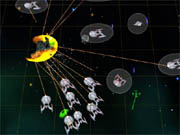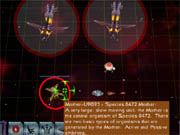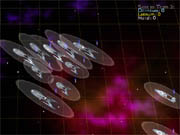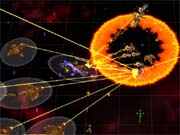Released in early 2000, Star Trek: Armada was a well-built, graphically impressive real-time strategy game that let you command the famous ships of the Star Trek: The Next Generation television series. The game wasn't overly complicated as real-time strategy games go--the object was to quickly try to gather enough resources to field a large fleet of starships powerful enough to dispose of all the enemy forces. Still, Armada was paced well, had some tactical depth, and was essentially fun to play. Some Star Trek fans felt its fairly simple gameplay didn't do justice to the source material, but most found Armada to be a refreshing change from the typically lackluster Star Trek games that had come before it.

At any rate, there was certainly room for a good sequel. Some sequels simply expand on the concepts of the original game--they introduce new graphics and a few new features. Other sequels are more ambitious in nature, and Star Trek: Armada II is one of these. You can't tell just on first impression--the look and basic design of the game remain largely identical to its predecessor. However, a number of new complexities have been introduced in Armada II, which make it seem more compelling than the first game from a strategic standpoint. Unfortunately, in practice not all of these new features are successful. In fact, if you enjoyed the original Armada, you might find yourself nostalgic for that game while playing Armada II.
Armada II is the first product from Mad Doc Software, a company founded by one of the key individuals behind some of Activision's successful real-time strategy games, including Dark Reign, Battlezone, and the original Star Trek: Armada. On paper, Armada II sounds like a perfect sequel. In addition to the Federation, Klingon, Romulan, and Borg playable factions from the first game, Armada II also lets you play as the cruel Cardassians and the enigmatic yet decidedly hostile Species 8472, though these two are only available in the skirmish and multiplayer modes. New ships and technologies have been added to each of the returning factions. There's a new, linear campaign consisting of 30 single-player missions--10 for the Federation, 10 for the Klingons, and 10 for the Borg. New tactical options are available--ships can be set into a number of formations, and battles now play out in true 3D space. By comparison, in the original Armada, battles took place on what was essentially a flat 2D playing field. Armada II also adds more layers to the original game's resource model.
Not all of Armada II's gameplay additions are effective, even if they sound attractive. For example, the ability to move your ships in a true 3D environment is just the sort of feature that some of Armada's fans hoped to see in a sequel. Unfortunately, the ability to do battle in true 3D space is really of negligible benefit to the game and actually introduces some new problems to how it plays. Though you can zoom the camera in for a close-up view of your ships, you'll spend the vast majority of your time with Armada II looking at your fleet from a top-down perspective, much like you'd find in most any real-time strategy game. Thus having the ability to move ships "up" and "down" relative to this perspective can be a tricky affair. It's easy enough to do--you use the Shift key, much like in the popular outer-space strategy game Homeworld, to set a destination for your ships along the Z-axis.

The problem is, at a glance, you can't really tell what's where. What looks like space debris might actually be a fleet of powerful starships too far "down" for you to notice. Meanwhile, ships sent all the way "up" can fill the screen. This can be used to devious effect in multiplayer matches--the relative sizes of your units can be carefully concealed by moving them along the Z-axis, so that even at resolutions exceeding 1024x768, it can be very difficult to tell what sorts of ships you're dealing with. There's a "tactical" view mode that lets you see the action from more of a side angle, which gives a better sense of relative distances between ships, but this view is otherwise disorienting and mostly just adds some cinematic flair to the action. It's not an ideal perspective for actually playing the game. At any rate, the addition of the Z-axis may indeed add a new level of strategy to the combat, but since much of the strategy revolves around taking advantage of flaws in the game's default perspective to trick human opponents, it's not the kind of depth that's entirely welcomed.
In any case, battles just don't last long in Armada II. For one thing, you'll find yourself bringing more ships to the fray than you did in the original game. In Armada, a well-balanced fleet of about a dozen ships could easily sweep across the map. In Armada II, most ships are produced very quickly, but also seem to get destroyed more easily, which means you'll use greater numbers of them. It also means you'll probably ignore the weaker ships and try to work your way up to the stronger, sturdier ones as quickly as possible. This isn't really satisfying--the first Armada gave a pretty good sense that you were indeed commanding powerful starships. When one of your bigger vessels was destroyed, that was a real blow to your force. In Armada II, ships are more expendable. Considering that most of Star Trek is about the drama that takes place aboard these vessels, the idea that they can be thrown wave after wave to their deaths seems misguided.
Armada II's ships fire and turn very quickly--they seem to have little mass--and their jerky motions further diminish the sense that they're actually huge spacecraft with hundreds or thousands of crewmembers aboard. Ships apparently take damage differently depending on their facing, but in practice this doesn't seem to mean much--a few ships bearing down on a single target can usually decimate it in no time, regardless of what direction it's pointed in.

Armada II lets most ships travel at warp speed, another new feature. They'll seem to elongate and will travel at a much faster rate across the map. In this state, ships are more vulnerable and their line of sight is reduced. It's a nice way of balancing out an ability that you'd expect most any Star Trek vessel to have. In practice, it's great for when you need to quickly reinforce a fleet engaged in battle or defend a vulnerable base. Maps in Armada II can be quite large, so being able to traverse them at high speeds is a relief. Actually, warp speed gives you a lot of leeway that you don't get in other real-time strategy games, where you need to have your units in the right place at the right time.
Warp speed isn't the only new feature that makes Armada II's combat seem rather forgiving. Since the pacing of Armada II's battles is much quicker than before, the designers added some options for allowing units to autonomously fire their special weapons. The special weapons in the original Armada worked just like those in games such as Warcraft II or Starcraft. Basically, you could spend resources to research special weapons for your individual ship classes, and then you'd need to manually trigger the attack when the time was right. Some have criticized this approach over the years--the idea being that manual dexterity shouldn't be a factor in a strategy game. At any rate, by giving you the option to let your ships fire off their special weapons autonomously, Armada II makes this hot topic a nonissue. In doing so, it penalizes those players who actually like the challenge of having to manually use these attacks, since the computer will always be quicker on the draw. Then again, the computer will also be prone to wasting the attacks on insignificant targets. Overall, much like the addition of the Z-axis, the option for greater unit autonomy in Armada II is something that's not quite successful in practice. It feels like a compromise, because it is one.
The changes to the resource model of Armada II are better than the changes to the tactical combat. The original game featured one basic resource you had to gather--dilithium--plus crew, which constantly regenerated and essentially limited the rate at which you could produce ships. Armada II adds the resources of metal and latinum to the mix. Metal is used in conjunction with dilithium to make ships but mostly to make new facilities. It's mined from planets, and most of the factions do this by constructing orbital mining facilities on planets found throughout each map. Latinum is a precious resource gathered from gold-colored nebulas and is mostly used for researching new technology. Also, planets can now be populated using colony ships, and this increases the rate at which you gain more crew. Not all races treat all the resources the same way. The Borg have no need for latinum. Species 8472 need only "bio-matter" and have no use for the basic resources the other races require. Most factions can now build a trading station facility, which can be used to buy or sell the various resources.

The more-complicated resource model in Armada II demands that you aggressively expand your territory to gain the funds you'll need to win. It's certainly a more interesting system than that of its predecessor, especially in how the demand for various resources varies somewhat for the different factions. However, once you weigh the resource gathering against the breakneck pacing of the combat, you'll find that the game really boils down to the resource gathering. You need to concentrate on gathering a lot of resources as quickly as possible and then building up a force that can sweep the map and crush the resource-gathering operations of your foes before they can do the same to you. The original Armada's resource system was simplistic--you just threw a few mining vessels at nearby sources of dilithium--but it let you concentrate on the tactical combat. The sequel's focus on resource gathering isn't necessarily the best direction it could have gone in.
Star Trek: Armada II's single-player campaigns are fairly conventional. There are usually multiple mission objectives in each scenario, and they're not always so basic as having to eliminate all the opposition. Though the Romulans, the Cardassians, and Species 8472 don't get their own campaigns, you'll run into them while playing as the other factions. Unfortunately, you might also run into a few bugs--the program shut down sporadically on our test systems, and strange things sometimes happened in the game, such as friendly units spontaneously firing on each other. Armada II features original voice-over from Patrick Stewart and a plot that should be satisfying to fans of the television series. These fans will also appreciate that Armada II sounds great--each of the game's six factions has its own well-done unit acknowledgments and music, although many of the sounds come straight from the original game, and the high-quality music plays in relatively short loops.
Armada II's instant action (or skirmish) and multiplayer modes let you play against up to seven human-controlled or computer-controlled opponents. Though three difficulty options are available, the computer doesn't pose much of a challenge regardless and merely seems to rally its forces quicker at the tougher settings. But it still can't seem to defend itself against a large, concentrated attack against its main base. Since base defenses are quite powerful in Armada II, beating the computer becomes a matter of quickly expanding, then setting up defenses, then biding your time until you've amassed a huge fleet.

Multiplayer Armada II has a built-in server browser through GameSpy, and you should be able to find enough competition. There are a few alternate multiplayer game modes, such as one that focuses on planet colonization and defense, but these are mostly just diversions to the core game. Both the skirmish and multiplayer modes are quite customizable--you can toggle on or off special weapons, warp speed, and more. In a telling gesture, you can also adjust the computer's build times and resource costs, effectively letting it buy things cheaper and make them faster than you can, in case you want to give it an edge to compensate for its basic lack of skill.
Armada II looks similar to its predecessor, but its predecessor's once-impressive graphics haven't aged well. The 3D ships look rather flat and can be very difficult to differentiate from one another when you're playing from the zoomed-out view. Armada II's maps are filled with colorful gaseous swirls that are a bit garish. Destroyed ships merely seem to split apart at the seams. The fog of war enshrouding each map is an ugly coat of solid gray. But perhaps the most frustrating aspect of Armada II's appearance is that an interface panel takes up about a third of the screen, even when you're playing at high resolutions. Some of the graphical effects still look great--phasers and photon torpedoes still light up the screen, and you can see little lights blinking on many of the ships. The six factions all look quite different from one to the next, too, and their respective spacecraft do look sufficiently similar to their television counterparts. But within each faction, it will take you some time to tell the differences between their ships and their structures. Fortunately or not, most of the factions are roughly similar in the sorts of ships and structures they have available. For instance, every side now has an "artillery" ship, capable of long-range bombardment. In Armada, only half of the factions had access to these extremely powerful units.

That's not to say all of Armada II's factions are the same. All of them have unique technologies and several noteworthy twists. Likewise, though Armada II may not be an entirely successful game, some aspects of it are undeniably well done. For instance, those who played the original Armada might recall that the game didn't give a good sense of its units' relative sizes. Some Federation vessels were as large as Borg cubes, which are supposed to be much, much larger. In the sequel, the Borg get their dues--eight cubes can be assembled into a fusion cube, a truly enormous battle station bristling with high-powered weapons. Despite the addition of larger spacecraft such as these, the game's battles run smoothly on midrange to high-end systems, even when dozens of ships are firing and exploding onscreen. The gameplay does bog down if you view it from the tactical angle, though. It's also worth noting that Armada II simply has a lot of stuff in it. There are plenty of ships available to each faction, and all of them can gain one or more special abilities. Armada II basically plays well--its interface is easy to get used to and its controls are responsive--so figuring out the game's little details can be enjoyable.
The main problem with Armada II is that, in changing some of the original game's focus, it seems to lose sight of that game's goal to give you the sense that you're marshaling huge capital ships into battle. It's unfair to just criticize the developers for trying to enhance the complexity of the original game--that's exactly what many players clamored for, and to Mad Doc's credit, the new gameplay features added to Armada II are unconventional and basically interesting. Even so, Star Trek: Armada's own title gives a concise description of what it ought to be all about--controlling Star Trek's massive, memorable starships in outer-space wars against alien foes. Last year's Star Trek: Armada used a direct approach to good effect. The sequel is more ambitious, but ultimately doesn't fare quite as well. So it probably won't completely satisfy those who enjoyed the first Star Trek: Armada, though with that caveat aside, it can still be recommended. After all, Armada II is a good real-time strategy game by any other standards and should particularly appeal to Star Trek fans willing to suspend their disbelief a little more than usual.